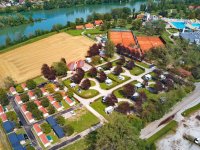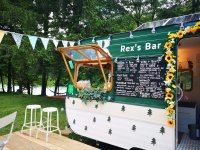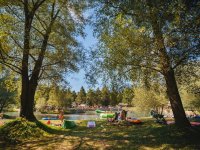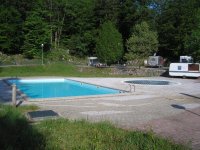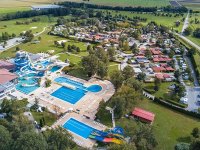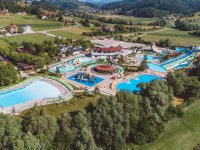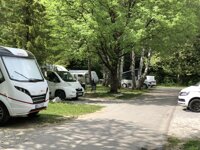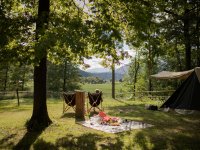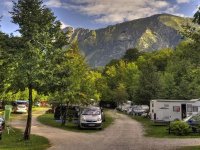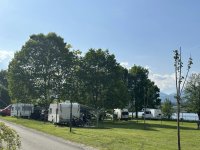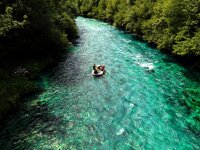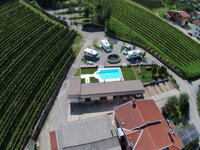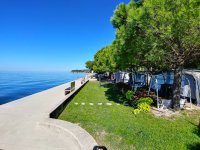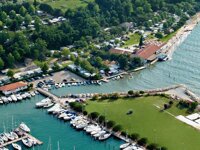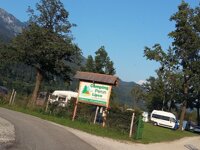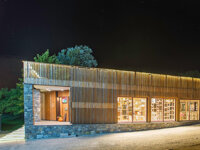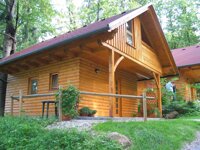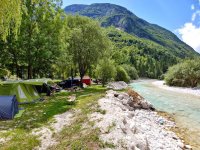Camping in Slovenia
38 campsites in Slovenia
Campsite Listing Google Map
The following consent is required:
Tracking & performance, Targeting & advertising.
Slovenia
Slovenia is something of a hidden gem when it comes to holiday destinations. Like its neighbour, Croatia, it remains unblighted by mass tourism, making it the perfect place for campers and caravanners looking to truly escape. What Slovenia lacks in size it makes up for in exceptional beauty, it has a diverse landscape with stunning Alps, rivers, forests and the warm Adriatic coast.
With its snow-capped Julian Alps and the picturesque Triglav National Park, which includes the beautiful lakes of Bled and Bohinj and the peaceful Soca River, it is no wonder that the northwest region of Slovenia is so popular. Stretching from the Alps down to the Adriatic coast is the picturesque Karst region, with pretty olive groves and thousands of spectacular underground caves. Although small, the Adriatic coast has several bustling beach towns, such as the Italianised Koper resort and the historic port of Piran, with many opportunities for watersports and sunbathing.
The capital, Ljubljana, is centrally located; with Renaissance, Baroque and Art Nouveau architecture, you will find most points of interest along the Ljubljana River. Heading eastwards, the landscape becomes gently rolling hills and is largely given over to vines (home of Lutomer Riesling). Savinja, with its spectacular Alps, is the main area for producing wine.
With over half the country being forested, camping in Slovenia can feel like a superbly wild experience. It has a diverse range of plant and animal life in its extensive woodlands and mountain areas, and ‘green tourism’ is heavily promoted to encourage the preservation of these beautiful natural environments. There are numerous walking trails and cycling routes to enjoy, as well as rafting and kayaking experiences for anyone looking to see the countryside from a different perspective.
The country’s star attraction is its karst cave systems, particularly the Postojna and Škocjan Caves. These labyrinths of echoing chambers and passageways wind for 6km and feature remarkable stalactite formations. The Murmuring Cave, part of the Škocjan system, is supposedly the largest subterranean canyon in the world.
Camping in Slovenia affords other delights besides the natural highlights. Towns such as Piran and Kobarid offer an insight into the country’s long history, and its capital, Ljubljana, is a vibrant city with a colourful central market, beautiful architecture and an impressive castle.
Unknown matrix block type: tableOfContents2!
Basic Information

Capital Ljubljana
Currency Euro
Language(s) Slovak
Time Zones CET (UTC+01)
Summer (DST) CEST (UTC+02)
Telephone Code +386
Units Metric
EU Member Yes
Schengen Area Yes
Tourism Website www.slovenia.info
Slovenia is a member of the European Union, and customs inspections are occasionally conducted on individuals and vehicles crossing the border to ensure compliance with Slovenia's regulations.
Shopping in Slovenia

Slovenia stands out for its contribution to the field of design. This can be seen in the clothes of Slovenian fashion houses, most of them concentrated in the capital city. The capital city is a hub for shopping. The central area around Preseren Square and the old town has numerous shops selling fashion, accessories, cosmetics, and souvenirs. Stroll along Čopova Street and Miklošičeva Street for a variety of options. Major cities like Ljubljana, Maribor, and Koper boast modern shopping centres, such as BTC City in Ljubljana, Europark in Maribor, and Planet Koper. These centres host many international brands, fashion, electronics, and entertainment options.
Open-air markets are an essential part of Slovenian shopping culture. Central Market in Ljubljana is a must-visit, offering fresh produce, local cheeses, meats, and local wine. Other notable markets include the Open Kitchen Market (Odprta Kuhna) and the Sunday Antique Market. Look for traditional Slovenian crafts and souvenirs like handmade lace, wooden products, ceramics, and honey. Slovenia is also known for its excellent wine. It is a hidden gem in the world of wine, boasting a diverse range of wine regions and varieties. Wineries produce limited quantities of high-quality wines, making them excellent choices for unique and memorable souvenirs.
Shopping hours in Slovenia can vary depending on the type of store, location, and day of the week. Generally, during the week, most shops and stores are open from around 9:00 a.m. to 7:00 p.m., Monday through Friday. Shopping centres and larger stores may have longer opening hours, often until 9:00 p.m. Saturdays are typically from 9:00 a.m. to 1:00 p.m. Shopping centres might stay open until 4:00 p.m. On Sundays, most shops are closed. It is also common for smaller shops and boutiques to be closed for lunch between 12:00 p.m. and 3:00 p.m.
Money
Slovenia uses the euro as its official currency. ATMs are readily available in almost all towns and cities, although it is advisable to carry some cash, especially when visiting smaller towns and villages where card acceptance may be limited.
Public Holidays
- New Year's Day: January 1st
- New Year Holiday: January 2nd
- Prešeren Day, the Slovenian Cultural Holiday: February 8th
- Easter Sunday, Easter Monday and Whit Sunday
- Day of Uprising Against the Occupation: 27 April
- May Day: May 1st
- Mayday Holiday: May 2nd
- Statehood Day: June 25th
- Assumption Day: August 15th
- Reformation Day: October 31st
- Day of Remembrance for the Dead: November 1st
- Christmas Day: December 25th
- Independence and Unity Day: December 26th
Please note Some dates are moveable, so please check before travelling.
Driving in Slovenia
Visitors to Slovenia who wish to drive in the country must comply with the following requirements:
- A valid driver's license: Visitors must have a valid driver's license from their home country.
- Car insurance: Visitors must have valid car insurance for their vehicle, covering both the driver and passengers.
- Vehicle registration: Visitors must have a valid vehicle registration for their car, which must be displayed on the vehicle.
- Vehicles registered in the UK must display the letters “UK” when driving in Slovenia. The identifier can be incorporated in vehicle number plates (along with the Union Flag) or as a separate sticker.
- Road rules: In Slovenia, you drive on the right and overtake on the left. Vehicles from the right and emergency vehicles have priority. The use of seat belts is mandatory for all occupants of a vehicle. Visitors must follow Slovenia's traffic laws, including speed limits, traffic signals, and road signs.
- To use Slovenian motorways, you'll need to display a vignette on your windscreen as proof of payment.
- Safety equipment: A red warning triangle is compulsory in case of an accident or breakdown. It is recommended that visitors equip their vehicle with a fire extinguisher and a first-aid kit, reflective jacket and spare bulbs for external lights.
- Minimum driving age: The minimum driving age is 18 years old.
- Alcohol law: The legal drink-drive limit in Slovenia is 0.05%. There's a zero-tolerance policy for novice drivers or those under the age of 21. Police can carry out roadside tests randomly or if they suspect you of being over the limit.
- From the 15th of November to the 15th of March, your vehicle must be fitted with winter tyres.
Emergency Services
- European Emergency Number 112
- Police 113
Places of interest
Adriatic Coast: Venetian Gothic architecture can be found at Piran, the best beach along the coast is at Fiesa.
Julian Alps: Mt Triglav is the country’s highest peak, Bled Castle, Bled Island has a 15th-century belfry with a ‘bell of wishes’, Lake Bohinij.
Ljubljana: Municipal Museum, National Museum, Museum of Modern Art all along the banks of the Ljubljana River, Tivoli Park with bowling alleys, tennis courts, swimming pools and a roller-skating rink.
Skocjan Caves: Filled with stalactites and stalagmites and housing 250 plant varieties and five types of bat.
Cuisine of the region

Traditionally the cuisine mainly consists of venison and fish, but there are Austrian, Italian and Hungarian influences.
Dunajski zrezek: Wiener schnitzel
Golaz: Goulash
Klobasa: A type of sausage that is smoked and roasted. It is often served with sauerkraut and potatoes.
Idrijski žlikrofi: Small dumplings filled with potatoes, onions, and spices, and served in a brown sauce.
Potica: A rolled cake filled with a variety of ingredients, such as nuts, raisins, or poppy seeds. It is a popular dessert for special occasions.
Paprikas: chicken or beef stew
Struklji: Cheese dumplings
Zavitek: Strudel
Weather
SLOVENIA WEATHERDespite its small size, Slovenia has a surprising variety of climates. There is a continental climate in the northeast, a severe Alpine climate in the high mountain regions and a sub-Mediterranean climate in the coastal area.
Spring in Slovenia is characterised by gradually warming temperatures and blossoming nature. With occasional rain and snow, March can still be chilly, especially in higher elevations. As you move into April and May, temperatures rise, and the landscape becomes more vibrant with blooming flowers and trees. Summers are generally warm and pleasant, making it the peak tourist season. Average temperatures can range from 20°C to 30°C, but heatwaves with temperatures exceeding 30°C are also possible. The coastal areas, such as Piran and Portorož, tend to be warmer and more humid than the inland regions.
Autumn brings cooler temperatures, but September can still offer pleasant weather for outdoor activities; as you move into October and November, temperatures drop, and rain becomes more frequent.
Winter in Slovenia varies in severity depending on the region and elevation. In the lowlands, winters are generally cold, with temperatures hovering around the freezing point, while the Alpine region experiences heavy snowfall and colder temperatures. Ski resorts in the Julian Alps and Pohorje Mountains are prevalent during this time.
Slovenia is a relatively wet country, mainly due to its location. The north-west of Slovenia is one of the wettest regions in Europe. Because of the relatively large amount of precipitation, you will find beautiful, green nature reserves in Slovenia.
